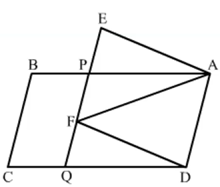Prove that the area of the parallelogram formed by the lines xcosα+ysinα=p,xcosα+ys∈α=q,xcosβ+ysinβ=randxcosβ+ysinβ=sis±(p−q)(r−s)cosec(α−β).
To prove that the area of the parallelogram formed by the lines xcosα+ysinα=p, xcosα+ysinα=q, xcosβ+ysinβ=r, and xcosβ+ysinβ=s is given by
Area=±(p−q)(r−s)csc(α−β),
we can follow these steps:
Step 1: Identify the lines
We have four lines:
1. L1:xcosα+ysinα=p
2. L2:xcosα+ysinα=q
3. L3:xcosβ+ysinβ=r
4. L4:xcosβ+ysinβ=s
Step 2: Find the direction vectors
The direction vectors for the lines can be derived from the coefficients of x and y:
- For lines L1 and L2 (which are parallel), the direction vector is d1=(cosα,sinα).
- For lines L3 and L4 (which are also parallel), the direction vector is d2=(cosβ,sinβ).
Step 3: Calculate the area of the parallelogram
The area A of the parallelogram formed by two vectors d1 and d2 can be calculated using the formula:
A=|d1×d2|
In two dimensions, the area can be expressed as:
A=|d1||d2|sin(θ)
where θ is the angle between the two vectors.
Step 4: Calculate the magnitudes of the direction vectors
The magnitudes of the direction vectors are:
|d1|=√(cosα)2+(sinα)2=1
|d2|=√(cosβ)2+(sinβ)2=1
Step 5: Find the angle between the vectors
The angle θ between the vectors d1 and d2 is given by:
θ=α−β
Step 6: Substitute into the area formula
Thus, the area of the parallelogram can be expressed as:
A=1⋅1⋅|sin(α−β)|=|sin(α−β)|
Step 7: Consider the distances between the parallel lines
The distance between the lines L1 and L2 is given by:
d1=|p−q|√(cosα)2+(sinα)2=|p−q|
The distance between the lines L3 and L4 is:
d2=|r−s|√(cosβ)2+(sinβ)2=|r−s|
Step 8: Final area expression
Thus, the area of the parallelogram can be expressed as:
A=|p−q|⋅|r−s|⋅|sin(α−β)||sin(α−β)|=±(p−q)(r−s)csc(α−β)
Conclusion
Therefore, we have proved that the area of the parallelogram formed by the given lines is:
Area=±(p−q)(r−s)csc(α−β)
We have four lines:
1. L1:xcosα+ysinα=p
2. L2:xcosα+ysinα=q
3. L3:xcosβ+ysinβ=r
4. L4:xcosβ+ysinβ=s
The direction vectors for the lines can be derived from the coefficients of x and y:
- For lines L1 and L2 (which are parallel), the direction vector is d1=(cosα,sinα).
- For lines L3 and L4 (which are also parallel), the direction vector is d2=(cosβ,sinβ).
The area A of the parallelogram formed by two vectors d1 and d2 can be calculated using the formula:
The magnitudes of the direction vectors are:
The angle θ between the vectors d1 and d2 is given by:
Thus, the area of the parallelogram can be expressed as:
The distance between the lines L1 and L2 is given by:
Thus, the area of the parallelogram can be expressed as:
Therefore, we have proved that the area of the parallelogram formed by the given lines is:
Topper's Solved these Questions
Similar Questions
Prove that the area of the parallelogram formed by the lines xcosα+ysinα=p,xcosα+ys∈α=q,xcosβ+ysinβ=randxcosβ+ysinβ=sis±(p−q)(r−s)cosec(α−β).
View SolutionArea of the parallelogram whose sides are xcosα+ysinα=p,<br>xcosα+ysinα=q,<br>xcosβ+ysinβ=r,<br>xcosβ+ysinβ=s is ………..
View SolutionThe area of the parallelogram formed by the lines xcosα+ysinα=p,xcosα+ysinα=q,xcosβ+ysinβ=r and xcosβ+ysinβ=s for given values of p, q, r and s is least, if (α−β)= (A) ±π2 (B) π4 (C) π6 (D) π3
View SolutionIf pandp be the perpendicular form the origin upon the straight lines xsecθ+ycosecθ=aandxcosθ−ysinθ=acos2θ
Prove that : 4p2+p2=a2View SolutionThe roots of The roots of both the equation sin2x+psinx+q=0andcos2x+rcosx+s=0 are αandβ, Then the value of sin(α+β)=
View SolutionThe perpendicular form the origin on the line joining the points P(rcosα,rsinα) and Q(rcosβ,rsinβ) divides PQ in the ratio 1 : k then principal value of cos−1(1k)
View SolutionIf the straight line xcosα+ysinα=p touches the curve x2a2+y2b2=1 , then prove that a2 cos2α+b2 sin2α=p2 .
View SolutionThree points A,B,C are in a line inclined at an angle θ to the horizon of three points. A is the lowest and C is highest. D is a point vertically above C. if AB=p,CD=q,∠DAB=αand∠DBC=β, then
cosθ=psinαcosβqsin(β−α)View SolutionP(α,f(α)) and Q(β,f(β)) are ends of an arc in the first quadrant. The area bounded by the arc, ordinates through P and Q, and the x-axis is (A) ∫f(β)f(α)f−1(y)dy (B) ∫βαf−1(y)dy (C) ∫βαf(x)dx (D) ∫f(β)f(α)f(x)dx
View SolutionIn Figure ABCDandAEFD are two parallelograms. Prove that: PE=FQ
 View Solution
View Solution
